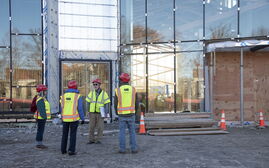Cow health monitoring co. targets $10B U.S. market
 Photo / Darren Fishell
Brian Walsh, co-founder of Vital Herd Inc., operates the startup company from an office at his South Portland home. Walsh and his family relocated from San Francisco early last year to be closer to the company's other co-founder, Karim Gabriel, who is based in western Massachusetts.
Photo / Darren Fishell
Brian Walsh, co-founder of Vital Herd Inc., operates the startup company from an office at his South Portland home. Walsh and his family relocated from San Francisco early last year to be closer to the company's other co-founder, Karim Gabriel, who is based in western Massachusetts.
Brian Walsh thinks he’s got a pill for dairy and cattle farmers’ woes. In April 2012, Walsh and partner Karim Gabriel founded Vital Herd Inc. This July and August, they’ve raised over $800,000 in an equity offering to bring the Falmouth-based startup’s electronic bovine health-monitoring transmitter to market.
“The value is big data for dairy and beef production,” says Walsh, the company’s president and CEO. “Today, a feed yard or feedlot manages their cattle’s health and nutrition by visual clues and they’ve been doing that since the cowboy days.”
And going by sight alone can leave a lot unseen.
“Any sort of disease progression — and there are a lot in these kinds of operations —[if you're] using visual clues, you're catching them too late,” Walsh says.
The device, which is the size of a small pill (by bovine standards), measures in real-time a slew of vital statistics that otherwise require various sensors that would be prohibitively expensive, says Walsh, to use in monitoring each cow across an entire herd.
The cow ingests the pill and it settles in the rumen, the first of four stops in a cow’s digestive system, where it stays for the life of the cow, sending real-time data to a local network and a variety of computers and mobile devices to alert farmers, veterinarians and managers of specific health problems.
Based on mortality estimates from the U.S. Department of Agriculture, Walsh says the dairy and beef industries each represent upward of a $5 billion market for his company in the United States alone. That’s because around 40% of dairy cows get a debilitating illness during their three to five years of production and around 3% of cattle raised for beef die during their year on the feedlot before going to slaughter.
Uncovering the earliest, “sub-clinical” signs of illness in those cows can mean better, more consistent milk production and fewer deaths, Walsh says.
“Given the volume, it's around 3 million animals that are dying (each year),” Walsh says of the beef cattle industry.
For dairy cows, better information can also mean optimizing regimens for distributing feed, which Walsh says can be around 90% of a dairy farm’s operating cost.
Climbing mortality rates are also a problem in the dairy industry. In a paper on dairy cow deaths published by the American Association of Bovine Practitioners in September 2012, Colorado State University professor Franklyn Garry and co-author Craig McConnel wrote that mortality rates among dairy cows have risen steadily in the past 10 years, reaching over 10% per year in some states.
While the health problems contributing to that increase are various, Garry writes that veterinarians and milk producers across the industry “do not have the information required to appropriately manage the problem,” which is where Walsh sees his company’s opportunity.
By using just one device over the lifetime of a cow to measure temperature, pH, respiratory and heart rate and other behavioral and health statistics, Walsh says his company is able to significantly cut down the cost of tracking bovine vital statistics compared with conventional techniques.
He declined to disclose just how much each unit will cost, but he projects dairy producers will get an eight-fold return on their investment by having real-time data they can act upon.
“There’s a lot of consolidation in the beef and dairy industries,” Walsh says. “Herds are getting bigger, so you can manage them with economies of scale, but managing the individual animal is harder in a large-herd setting.”
Beyond posing a challenge for close monitoring, Garry and McConnel write that farm expansions are often joined by “substantial problems with animal health.”
Walsh says his company is aiming to solve that problem by making individual cattle monitoring affordable.
“The Holy Grail is that we can offer than the individual animal attention in a very time-economic and management-economic way through data,” Walsh says.
The company, which has a mailing address in Falmouth, a lab in Leominster, Mass., and a research collaboration with a Connecticut university, is now exploring markets for two different units, one with a three-to-five-year lifespan targeted for dairy farms and another with a one-year lifespan for beef cattle.
The company’s technology relies on a proprietary acoustic method for measuring certain vital statistics and passed its first tests in a live cow in Connecticut earlier this year, Walsh says. The unit provided data to a remote computer that the company then checked against traditional measurement methods to prove their device's accuracy.
Since moving to Maine early last year, Walsh says his company has also taken advantage of the University of Southern Maine’s Campus Ventures program, which aims to help companies commercialize products. Gregory Cavanaugh, USM’s director of external programs, says Vital Herd is a standout among the companies he’s worked with through the program.
“When (Walsh and Gabriel) came to us, they didn’t fit the profile of the typical company we get through the program,” Cavanaugh says. “They had a level of sophistication and polish to their pitch that is in a class completely different from what we normally see.”
Walsh, who was previously a principal at the San Francisco clean-tech venture capital firm, Nth Power, says he’s been on the company-building side of new ventures as an investor but always felt drawn to the entrepreneurial end of things.
“It’s riskier, but it’s more rewarding,” he says.













Comments